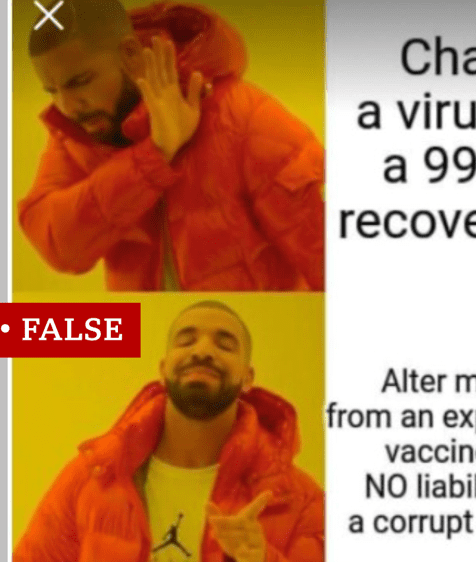
Amid promising announcements from companies like Moderna and Pfizer on the progress of a COVID-19 vaccine, and during the initial phases of a massive vaccination program, American reactions on social media have varied widely. Some are excited for their shot at getting vaccinated, but others have been skeptical that the vaccine is any safer than the virus itself. While Dr. Anthony Fauci, chief medical advisor of the White House Coronavirus Task Force, predicted that 75% to 85% of Americans will need to be immunized to stop the spread of the virus (Kum, 2020), only about 42% of Americans indicated that they would get the vaccine in a YouGov poll from August (Zadrozny, 2020). From anti-vaccination conspiracies to satirical memes, health officials now fear that social media may be a hurdle to reaching herd immunity as misinformation and hesitation online could undermine efforts to administer the vaccine to the majority of the population.
Though “opposition to vaccines is as old as the vaccines themselves,” the United States has witnessed a sudden growth in vaccination distrust since the early 2000s (Hussain et. al. 2018). While this has typically been associated with the debunked work of Andrew Wakefield who claimed vaccines cause autism in children, the novel coronavirus pandemic has brought a number of previously-unrelated groups into the contemporary anti-vaccination (“anti-vax”) movement (Hussain et. al., 2018; Zadrozny, 2020) Some of these groups include “Libertarian, New Age, QAnon, and anti-government groups, as well as more mainstream communities” who have utilized online memes to spread anti-vax rhetoric and misinformation. Often, these memes feature humorous and familiar imagery that couches conspiracy theories and/or inaccurate data ranging from unsupported claims of side effects to portraying “the vaccine as a cover for population control by a government ‘deep state,’ private philanthropists, or even Satan” (Zadrozny, 2020). For example, one viral meme that took aim at “pro-vaxers” features contemporary hip-hop artist Drake with a condemnatory expression while reading “chance a virus with a 99.97% recovery rate” followed a face of approval after reading “alter my DNA from an experimental vaccine with NO liability, from a corrupt industry” (Carmichael et al. 2020; “False” label added by researchers).
The meme works to make its point through contrast and humor: it appears to claims that it’s much safer to risk catching the virus than taking the vaccine. But there are problems with this humorous logic. Though the meme claims 99.97% of people infected with COVID-19 survive it, current statistics actually place this number at 99.0% (Carmichael et al. 2020). While this may appear to be an insignificant difference, Jason Oke, a Senior Statistician at the University of Oxford, points out that this means “100 in 10,000 will die – far higher than 3 in 10,000, as suggested in the meme” (Carmichael et al. 2020). Furthermore, the meme includes other misleading elements, such as claiming vaccines can alter human DNA, ignoring that health institutions are overburdened with coronavirus cases, overlooking large scale trials, and disregarding the fact that we do not have data on the long-term effects of COVID-19 (Carmichael et al. 2020). For all we know, every person who survives the virus may nonetheless suffer long-lasting health effects and intensive medical care in the future as a result of infection. Ultimately, argues Professor Liam Smeeth from the London School of Hygiene and Tropical Medicine, fearmongering memes like this which “break down taking the vaccine to an individual act misses the point of vaccinations” altogether – “it should be seen as an effort by [all of] society to protect others,” such as the elderly and immunocompromised (Carmichael et al. 2020).
Regardless of the urgent need to disseminate immunizations so that countless lives may be saved, the viral spread of anti-vax discourse online could severely decrease the willingness of the population to vaccinate. In particular, Facebook seems to be one of the main culprits as “groups formerly dedicated to merely asking questions about vaccines have switched to more vociferous anti-vaccine views in recent months” (Khazan, 2020). Some have argued that these spaces must be completely shut down and banned from the platform. After pressure from the public, Facebook recently took steps to do just that by banning popular anti-vax pages. Many see this as a promising first step to combat misinformation, but this solution may only be promising on its surface.
Despite the heavy hand that conspiracy and extremist groups have had in the process, the overall spread of misinformation regarding the COVID-19 vaccine is more complicated than it initially appears. While one may assume all anti-vaxers are “science denying-individualists,” this stereotype does not tell the whole story (Anderson, 2020). For example, taking into account America’s history of racist medical malpractice, from the Tuskegee Syphilis Study to the forced sterilization of racial minorities, many people of color do not trust that the COVID-19 vaccine is safe for their communities (Kum, 2020). Combine this with the fact that “a vaccine [usually] takes about 15 to 20 years to develop,” it is understandable why a large portion of the population are skeptical of coronavirus vaccines that were created in only a few months – a process that the Trump administration even dubbed “Operation Warp Speed” (Kum, 2020).
With points like these in mind, anthropologist Heidi Larson founded the Vaccine Confidence Project which aims to locate the origin of and, subsequently, dismantle misinformation about vaccines. Through her various studies of anti-vaxers around the globe, she concluded that they are often “people with genuine questions and doubts in search of guidance” (Anderson, 2020). As such, it is important to take seriously their concerns and respond with careful patience. Thus, Larson argues that banning popular anti-vax pages on Facebook would not ultimately halt the spread of vaccine hesitancy because social media is only a tool for misinformation, not the root cause. Instead, media and medical professionals should be working together to regain people’s trust in governments and pharmaceutical companies in general by having candid discussions with members of their community (Anderson, 2020). While such a goal will obviously take a long time, misinformation expert Seb Cubbon offers a framing solution to initiate in the meantime. For example, because restriction of freedom is often at the center of some vaccination debates, the converse point can be made that vaccination is necessary to get back to a “normal” life where facial masks are not required to enter buildings and travel is not restricted (Carmichael et al. 2020). Rather than silencing them completely, addressing their concerns in their own language could be a productive way of swaying anti-vax groups towards immunization (Carmichael et al. 2020).
In the end, it is important to remember that “vaccines don’t save lives; vaccinations save lives” (Anderson, 2020). Unfortunately, the aggregate reality of herd immunity means that social media will continue to be a hindrance until the underlying trust problem can be remedied. However, such a goal will take significant efforts and a lot of time. In the meantime, COVID-19 will keep spreading and the death toll will continue to rise. In times of crisis, should respect and patience for people’s misinformed yet legitimate concerns take a backseat to quick solutions, or does doing so set a dangerous precedent for the future?
Discussion Questions:
- How does COVID-19 vaccine hesitancy differ from vaccine hesitancy before the pandemic?
- Who are the different shareholders impacted by vaccine hesitancy? What are the conflicting interests or values of these shareholders?
- How much responsibility lies with social media platforms for failing to regulate their platforms versus the social media users who share misinformation?
- What are the possible value conflicts or tradeoffs that will emerge if social media platforms make a concerted effort to de-platform anti-vax speech?
- Where do you draw the line between harmless memes and harmful misinformation? Would all art (including humor) suffer if it was subject to tests of truthfulness or public safety?
Further Information:
Anderson, J. (October 13, 2020). “She Hunts Viral Rumors About Real Viruses.” The New York Times. Available at: https://www.nytimes.com/2020/10/13/health/coronavirus-vaccine-hesitancy-larson.html
Carmichael, F., & Goodman, J. (November 29, 2020). “COVID-19: What’s the Harm of ‘Funny’ Anti-Vaccine Memes?” BBC News. Available at: https://www.bbc.com/news/55101238
Heilweil, R. (November 9, 2020). “Is Social Media Ready for a COVID-19 Vaccine?” Vox. Available at: https://www.vox.com/recode/21527013/covid-19-vaccine-pfizer-safety-social-media-misinformation
Hussain, A., Ali, S., Ahmed, M., & Hussain, S. (2018). “The Anti-Vaccination Movement: A Regression in Modern Medicine.” Cureus, 10(7), e2919. https://doi.org/10.7759/cureus.2919
Khazan, O. (October 16, 2020). “Inside the Mind of an Anti-Vaxxer.” The Atlantic. Available at: https://www.theatlantic.com/health/archive/2020/10/how-change-mind-anti-vaxxer/616722/
Kum, D. (December 28, 2020). “Fueled by a History of Mistreatment, Black Americans Distrust the New COVID-19 Vaccines.” TIME. Available at: https://time.com/5925074/black-americans-covid-19-vaccine-distrust/
Reuters Staff. (November 9, 2020). “Vaccine Hesitancy May Undermine Fight Against COVID-19, UK Report Says.” Reuters. Available at: https://www.reuters.com/article/health-coronavirus-vaccine-hesitancy/vaccine-hesitancy-may-undermine-fight-against-covid-19-uk-report-says-idUKL8N2HV7J8
Zadrozny, B. (November 30, 2020). “COVID-19 Vaccines Face a Varied and Powerful Misinformation Movement Online.” NBC News. Available at: https://www.nbcnews.com/tech/tech-news/covid-19-vaccines-face-varied-powerful-misinformation-movement-online-n1249378
Zimmer, C. (October 12, 2020). “First, a Vaccine Approval. Then ‘Chaos and Confusion.’” The New York Times. Available at: https://www.nytimes.com/2020/10/12/health/covid-vaccines.html
Authors:
Kathryn Galanis, Kat Williams, & Scott R. Stroud, Ph.D.
Media Ethics Initiative
Center for Media Engagement
University of Texas at Austin
February 8, 2021
Images: Daniel Schludi on Unsplash / Carmichael et al., 2020.
This case was supported by funding from the John S. and James L. Knight Foundation. These cases can be used in unmodified PDF form in classroom or educational settings. For use in publications such as textbooks, readers, and other works, please contact the Center for Media Engagement.
Ethics Case Study © 2021 by Center for Media Engagement is licensed under CC BY-NC-SA 4.0




